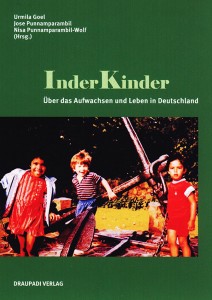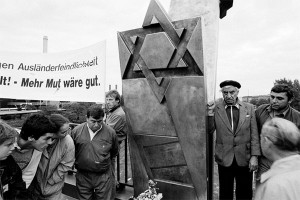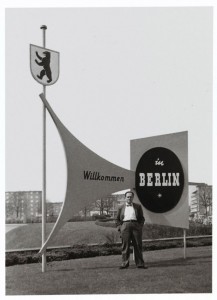Dealing Creatively with Ethnic Classifications

Book cover
© Draupadi Verlag
Tomorrow at the Academy of the Jewish Museum Berlin, Urmila Goel and Nisa Punnamparambil-Wolf will introduce the book they edited, InderKinder – Über das Aufwachsen und Leben in Deutschland (Indian-Children: on Growing Up and Living in Germany, published by Drapaudi Verlag). It’s the third in a series of events on “New German Stories” where, with the aid of individual biographies, we examine Germany’s historical and current status as an immigration society. On this occasion we’ll focus on the children of immigrants from India, who gained public awareness for the first time during the “Green Card” campaign of 2000.
Prior to the reading and discussion tomorrow, we asked the two editors, Nisa Punnamparambil-Wolf and Urmila Goel, three questions:
What made you choose this title?
We’re referring with this title to the marginalizing “Kinder statt Inder” (children instead of Indians) campaign of the year 2000. The wordplay of InderKinder (Indian-children) is meant ironically: it was important to us to find a creative way to deal with these attributions. With the book, we want to show the varied ways that people who grew up and live in Germany handle the classification of being a child of Indian immigrants.
The book consists of two parts, autobiographical stories and essays. How would you explain your concept?
→ continue reading
On Why the Death of Stuart Hall Is a Loss for our Academy Programs
Stuart Hall, the renowned British cultural theorist and sociologist, passed away exactly one month ago, on 10 February 2014. His death prompted in us a deep sense of personal loss. His groundbreaking writings on cultural studies, in particular on racial inequality, were first translated into German in the mid 1990s—a time when people here were beginning to acknowledge the importance of racism as an issue.

Silent vigil of the Jewish Community at the Putlitz Bridge Deportation Memorial
Photo: Michael Kerstgens, Berlin Tiergarten, 1992
Hall’s approach incited a new discussion and coined a new vocabulary: until then, Germans in the Federal Republic had spoken of “Fremdenfeindlichkeit” (xenophobia), which they regarded as a marginal social phenomenon. Politicians and the media spoke matter-of-factly of society “reaching breaking point” when “the boat gets too full” owing to “Überfremdung.” The latter term denotes the state of ‘being overrun by foreigners.’ It is itself deeply racist and was accordingly voted Non-word of the Year 1993. “Being overrun” was presumed however to be explanation enough for the fire-bombings and other attacks then being carried out almost daily on asylum-seekers’ accommodation centers or immigrants’ apartments—and likewise for the hate campaigns, man-hunts, and pogrom-type riots erupting in Rostock, Hoyerswerda, and elsewhere, or the emergence of no-go areas in other towns and rural centers. In consequence, the law on asylum was altered in 1993 such that judicial opinion held it to have been “de facto repealed.” Therefore, anyone who wished to address the issue of racism as a structural phenomenon and thereby draw on theoretically sound academic sources had necessarily to turn to authors from England, France, the USA, or Canada—and repeatedly to Stuart Hall. → continue reading
Fred Stein was only twenty-four years old when he had to flee Germany in 1933. A rabbi’s son and member of the Socialist Workers’ Party, he had studied law and hoped to work as an attorney, defending people’s rights. When he learned by chance that the Gestapo was planning to arrest him, he and his wife Lilo fled to Paris under the pretext of taking a honeymoon trip. In exile, the young couple was obliged to rethink its future.

Fred Stein, Berlin 1958
© Estate of Fred Stein
A Leica camera, the wedding present they had bought for themselves, proved to be the key to a new career. Fred Stein began taking photographs: street scenes in downtown Paris and portraits of celebrities, many of whom were German emigrants. In 1941 Fred and Lilo Stein, who by then had a little daughter, managed to flee a second time. They reached New York on one of the last ships out. There, Fred Stein once again devoted himself to shooting portraits and street scenes.
In 1958 Fred Stein returned to Germany for the first time in twenty-five years. He was prompted to do so by Will Grohmann’s planned publication of the book Deutsche Porträts [German Portraits]. Fred Stein was commissioned to photograph Konrad Adenauer, Heinrich Lübke, Ludwig Erhard, and other politicians, as well as artists, authors, and publishers, such as the young Axel Springer, or Rudolf Augstein. Yet apparently, many a German head he portrayed for the book posed a dilemma for him. → continue reading


